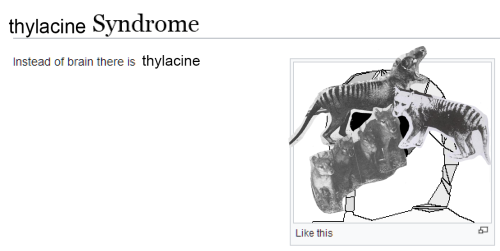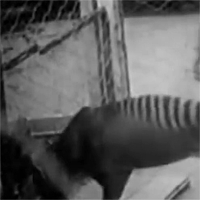I Feel Normal About Thylacines Why Do You Ask

i feel normal about thylacines why do you ask
More Posts from Moonlight-wolf-archive and Others







images of the thylacine you have probably never seen before

A group of thylacines relaxing in the Hobart Zoo, c. 1920’s.

do you remember how we used to run









Footage of the last Living Thylacines (Thylacinus cynocephalus) (1936)
“The question is, are we happy to suppose that our grandchildren may never be able to see an elephant except in a picture book?” - Sir David Attenborough


The tiny skull of a thylacine joey, part of the collection of the Smithsonian National Museum of Natural History. Prior to her premature death, this individual lived alongside her mother and two siblings at the Smithsonian National Zoological Park. [ x ]







some more images of the thylacine you have probably never seen before


Happy First Anniversary to @extinctionstories! When I set up this blog last May, I was mostly hoping for a way to organize my conservation-related work; if people happened to enjoy it, then that would just be a bonus. Instead, I've been blown away by the enthusiasm and interest that you guys have for my art and writing, and the love that we all share for these precious creatures. Thank you so much for listening to their stories; I have plenty more to come
As a birthday treat, here are a couple of quick thylacine studies that I haven't posted before. They are fountain pen and watercolor, on 18x24" paper.
Dobsegna: in some parts of Papua New Guinea
I've also heard moonlight wolf (hence the blog name lol) that's uncommonly used.
What’s in a name?
Just for fun, I thought I’d compile a list of names for the thylacine in various languages.
Scientific: Thylacinus cynocephalus (lit. ‘dog-headed pouched one’); formerly Didelphis cynocephala (lit. ‘dog-headed opossum’) [x]
English: Thylacine, Tasmanian tiger, Tasmanian wolf, zebra wolf, marsupial wolf - Uncommon/old names: Zebra opossum, dog-faced dasyurus, native hyena, native tyger
Aboriginal: Coorinna, loarinna, laoonana, lagunta [x]
Spanish: Tilacino
German: Beutelwolf (lit. ‘bag wolf’)
French: Loup marsupial (lit. ‘marsupial wolf’)
Japanese: フクロオオカミ (fukuro-ookami, lit. ‘bag wolf’)
Swedish: Pungvarg [thanks bigfishboss]
Finnish: Pussihukka
Do you know any others?
thylacines made good pets?? ;_; they do look like they'd feel soft and glossy to the touch. I'm obsessed with tassie devils, myself, but I'm resigned that they may go extinct before I can travel far enough to see them. I wish I could pet one.
They were obviously not domesticated to the level of having domestication syndrome features (not that I'm sure a marsupial animal *would*), but there are historical records of Tasmanians who kept them as pets, including both white settlers and indigenous people.
Thylacines were somewhat prone to capture myopathy (a stress reaction that causes some animals to die if trapped/captured) and sometimes died after capture, but many did not. If the animals were treated kindly they would generally respond well to attempts to tame them, and this was even more true of orphaned baby thylacines that were raised by humans. There are several stories of people who tamed thylacines very shortly after capture. One such thylacine was let go when she went into season and became restless, and she later introduced her pups to the man she had lived with.
Indigenous people were recorded as having kept them. One indigenous informant stated that they called them "stripey dogs" when they spoke English.
One of my favourite stories was of a white settler family had a large house and kept their thylacine on an extremely long chain in the front so that she could act as a sort of watchdog. This thylacine would watch over the children playing and did not react violently to them even if she was accidentally hit by a ball (she knew that this was an accident) and would give warning of anyone approaching.
The likely reason that thylacines did not become popular household companions was the hate campaign that sprung up around them, stating that they were sheep killers. Once that got to be a big issue and bounties were offered for killing them, people who were taming and raising the animals frequently found them killed, and they gave up on it.
Many of these stories are in Robert Paddle's book, which is an academic study but is extremely readable.
-
 tulipstogether reblogged this · 4 months ago
tulipstogether reblogged this · 4 months ago -
 rainy-rain-duck reblogged this · 4 months ago
rainy-rain-duck reblogged this · 4 months ago -
 videnoirs liked this · 6 months ago
videnoirs liked this · 6 months ago -
 lobotomyhaver liked this · 1 year ago
lobotomyhaver liked this · 1 year ago -
 officialgleamstar liked this · 1 year ago
officialgleamstar liked this · 1 year ago -
 bestlittlesnek reblogged this · 1 year ago
bestlittlesnek reblogged this · 1 year ago -
 shadowthian reblogged this · 1 year ago
shadowthian reblogged this · 1 year ago -
 shadowthian liked this · 1 year ago
shadowthian liked this · 1 year ago -
 dusty21134 reblogged this · 1 year ago
dusty21134 reblogged this · 1 year ago -
 two-eleven-thirty-four liked this · 1 year ago
two-eleven-thirty-four liked this · 1 year ago -
 canis-dingo reblogged this · 1 year ago
canis-dingo reblogged this · 1 year ago -
 canis-dingo liked this · 1 year ago
canis-dingo liked this · 1 year ago -
 zenstarling liked this · 1 year ago
zenstarling liked this · 1 year ago -
 caromoonhouse liked this · 1 year ago
caromoonhouse liked this · 1 year ago -
 itsnotalemon liked this · 1 year ago
itsnotalemon liked this · 1 year ago -
 algirdasgiedraitis reblogged this · 1 year ago
algirdasgiedraitis reblogged this · 1 year ago -
 algirdasgiedraitis liked this · 1 year ago
algirdasgiedraitis liked this · 1 year ago -
 asukafigure reblogged this · 1 year ago
asukafigure reblogged this · 1 year ago -
 asukafigure liked this · 1 year ago
asukafigure liked this · 1 year ago -
 foryouthegays reblogged this · 1 year ago
foryouthegays reblogged this · 1 year ago -
 ezrathebannanaruler liked this · 1 year ago
ezrathebannanaruler liked this · 1 year ago -
 hamenthotep liked this · 1 year ago
hamenthotep liked this · 1 year ago -
 toytowns reblogged this · 1 year ago
toytowns reblogged this · 1 year ago -
 toytowns liked this · 1 year ago
toytowns liked this · 1 year ago -
 gryphonmcelroy reblogged this · 1 year ago
gryphonmcelroy reblogged this · 1 year ago -
 gryphonmcelroy liked this · 1 year ago
gryphonmcelroy liked this · 1 year ago -
 ricefriedshrimp liked this · 1 year ago
ricefriedshrimp liked this · 1 year ago -
 the-floral-skeleton liked this · 1 year ago
the-floral-skeleton liked this · 1 year ago -
 thetrapperstrap reblogged this · 1 year ago
thetrapperstrap reblogged this · 1 year ago -
 karenhitchcock liked this · 1 year ago
karenhitchcock liked this · 1 year ago -
 where-is-god-now liked this · 1 year ago
where-is-god-now liked this · 1 year ago -
 scarybong liked this · 1 year ago
scarybong liked this · 1 year ago -
 in-vyn-cible reblogged this · 1 year ago
in-vyn-cible reblogged this · 1 year ago -
 in-vyn-cible liked this · 1 year ago
in-vyn-cible liked this · 1 year ago -
 spiraldrill liked this · 2 years ago
spiraldrill liked this · 2 years ago -
 feralscales liked this · 2 years ago
feralscales liked this · 2 years ago -
 trappedundercloud9 liked this · 2 years ago
trappedundercloud9 liked this · 2 years ago -
 hero-israel liked this · 2 years ago
hero-israel liked this · 2 years ago -
 alilweirddragons-reblog reblogged this · 2 years ago
alilweirddragons-reblog reblogged this · 2 years ago -
 alilweirddragon liked this · 2 years ago
alilweirddragon liked this · 2 years ago -
 noctilionoidea liked this · 2 years ago
noctilionoidea liked this · 2 years ago -
 ryderdire reblogged this · 2 years ago
ryderdire reblogged this · 2 years ago -
 ryderdire liked this · 2 years ago
ryderdire liked this · 2 years ago -
 anirlcryptid99 liked this · 2 years ago
anirlcryptid99 liked this · 2 years ago -
 linkzac reblogged this · 2 years ago
linkzac reblogged this · 2 years ago -
 linkzac liked this · 2 years ago
linkzac liked this · 2 years ago

Collection of media revolving around the Thylacine
149 posts
